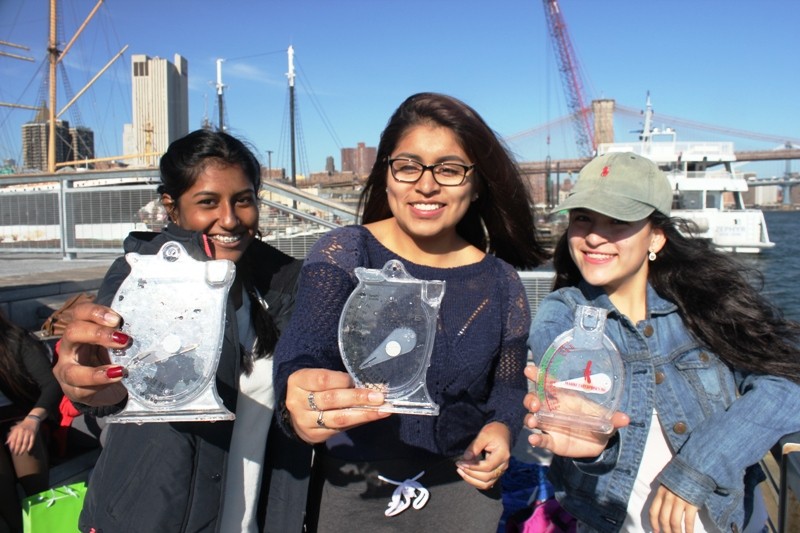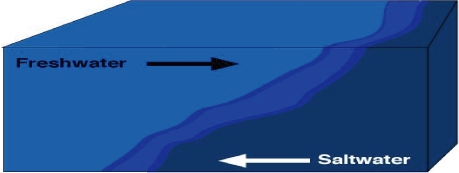Hudson River Estuary Basics
The Hudson River defines Eastern New York State. It runs a total of 315 miles, flowing from Lake Tear of the Clouds perched over 4000 feet up on the southwest side of Mount Marcy in the Adirondacks, all the way to the Battery at the southern tip of New York City. The Hudson's dynamic character makes it a unique waterbody. The northern half of the Hudson, from where it originates in the Adirondacks, to where meets the Troy Dam just above Albany, is a freshwater river that flows in a single direction. This stretch of the Hudson undergoes a significant change in elevation, flowing from very high ground to only 25-30 feet above sea level, as it moves towards the Atlantic Ocean.This stretch of the Hudson if fed by snowmelt, annual rains and groundwater.
The southern half of the Hudson is an estuary that is dominated by its tidal connection to the Atlantic Ocean. With only a small ~5 foot change in elevation along the full 153 mile length, tides push all the way in from the Atlantic Ocean up to the Troy Dam, creating mixing and transferring nutrients and resources from the ocean and the river. It is because of the influence of the tides that the Lenape, the original people of this area, referenced the constant movement of the river in their naming, Muhheakunnuk or Mahicannituck depending on their region. This has been translated as ‘the waters that are never still’ or ‘great waters in constant motion’. As a result of tides and currents, the Hudson estuary does not flow in one direction. Because the ebb tide is stronger than the flood tide, the river does ultimately flush itself, but residence time in the river can vary depending on the season and can take as long as 4 months!

In the estuary section, the tidal influence of the ocean creates a blend of seawater and freshwater that is not evenly distributed along this lower stretch of the waterway. Higher salinities are found closest to the Atlantic, exactly where fluctuate with the tides, rainfall and snowmelt. This section of the river is dynamic, experiencing dramatic changes in salinity, circulation patterns, tidal ranges, river width and water depth, fish species, macroinvertebrate communities, and plant communities. Through the Day in the Life event, these dynamic features emerge in the shared student collected data, putting together an image that best reflects the river itself. We hope that through their participation in this event the students will discover many new questions, as well as answer existing ones, thereby creating a lifelong learning relationship with the river.
Understanding Estuary Basics
Tides are what makes the estuary so dynamic! Every 6 hours the tides shift pushing water into the river mouth from the Atlantic Ocean on a flood tide, and pulling water back out the mouth on an ebb tide. In the estuary section, measuring the tides is an important part of Day in the Life as many of the parameters change with the changing tide!
Ranges -The difference in height between high tide and low tide varies with:
- Location: In the midriver section the tidal range can be less than 3 feet, while the range at the Troy dam can be close to 5 feet due to the narrowing of the channel.
- Stage of the moon. During a full moon and new moon, the strong gravitational pull causes very high and very low tides resulting in a larger tidal range called a spring tide. During the mooon's quarter phases the tidal ranges are at their lowest called a neap tide, which in some sections of the river this can be as low as 1 foot!
The tides themselves move nutrients and minerals all throughout the estuary supporting the biology that lives there. Tidal ranges can also affect the plants and animals. In areas where low tides expose wide mud flats there will be plants and animals that are specifically adapted that that type of habitat.
Currents in the Hudson are created by the tidal movement of the water. The rise and fall of the tides changes the flow of the water, tugging it in and out of the estuary and creating the currents. The timing of the currents mimics the rise and fall of the tides, following roughly a six hour schedule. Extremes in weather, such as excessive rains or strong winds, can impact the currents by overwhelming or suppressing them. In some places on the river, change in water color or surface movement can reflect the current, but a surface movement does not always reflect the stronger deeper flowing current below.
In measuring currents it is important to use something with enough density that it sits down deep enough to feel the internal water movement. We use an orange since it has enough density to sit in the current, is bright and visible, is biodegradable.
Salinity is an important and fascinating part of the Hudson River Estuary. Salt water is denser than freshwater causing salty Atlantic seawater to push into the lower estuary. Remember 'mass' measures how much there is of something, while density measures high tightly it is packed together. The salty water enters as a wedge, using gravity to push its way into the river along the bottom, as freshwater runs downriver washing over the top. The saltwater stays on the bottom since it is denser than freshwater (see image).
Salinity in the Hudson River estuary ranges from close to seawater (35,000 ppm) at the mouth of Sandy Hook, N.J., to background levels (~20-30 ppm) in freshwater further north on the river. As the water moves into the estuary and moves further away from the ocean it begins to mix more readily with the freshwater creating an area referred to as brackish. We often refer to different sections of the estuary as Marine (where the salinity is >18,000 ppm), brackish (<18,000 but > 100 ppm), and freshwater ( <100 ppm).

The strength of the saltwater pushing in from the ocean, or to the volume of freshwater running downriver from the north is not a constant. Seasonally there are increases in the amount of freshwater with rains and snowmelt forcing the saltwater intrusion south, and then periods of hot dry days where freshwater additions lessen and the saltwater pushes north.
The area that we consider the transition from salty to fresh is what is called the "salt front”. and is measured at 100 mg/L chloride concentration. To learn more about the salt front in the Hudson River check out the Hudson River real time monitoring system HRECOS.
Water chemistry is a controlling factor in the amount and types of fish, macroinvertebrates and even plants that will be able to thrive and exist in a given section of the river. Water chemistry is impacted by adjacent land uses, tides and currents, time of day, time of year, type of substrate and interactions between these variables as well as other more subtle factors.
-
Dissolved Oxygen (DO) - This is a measure of the concentration of oxygen gas dissolved in water and available for aquatic life. Oxygen enters the Hudson River primarily through diffusion from the atmosphere, turbulence caused by tides, winds and currents, and plant photosynthesis. A healthy range of DO are 5-11 mg/L (or ppm). The most oxygen that can be dissolved in water is ~14 mg/L.
-
Reduction in oxygen levels can result from storms leading to combined sewage overflows dumping sewage into the river, excessive nutrients causing algae blooms which die and use oxygen to decompose, or even really warm temperatures which mean the water can not hold onto the oxygen as well. '
-
Oxygen levels can drop to what is called hypoxic rates, or levels that would be considered unhealthy for marine organisms. Anoxic rates are levels where there is no oxygen available for marine organisms. Concerns for hypoxia and anoxia are greatest in the summer months when the river water is warmest and the water tends to move through the system more slowly due to a reduction in storms and winds.
-
Different living things require different levels of DO to exist and thrive. Certain fish such as trout require DO levels of at least 6 mg/L. Certain macroinvertebrates such as stonefly, caddisfly and mayfly also require higher levels of DO.
-
We also meanure the percent saturation of the oxygen in the water. This measurement tells us how much oxygen is really dissolved in the water and available for use by marine life. This is reached through measuring water temperature and oxygen levels.
-
-
pH (potential hydrogen) - A measure of water's acidity or alkalinity, ranges from 0-14 with 7 considered neutral. Many fish and invertebrates are sensitive to either very basic readings (above 8.6) or very acidic readings (below 6.5). The optimal range for most marine life is between 6.5 and 8.6. The Hudson River tending to be a bit on the basic side due to its bedrock geology and, especially in the lower section, the presence of seawater which tends to be about 8.0 as it carries calcium carbonate and other minearls. It is important to note that pH is a measure of the concentration of hydrogen ions and that the readings are logorithmic, so a change in one pH unit represents a tenfold change in the concentration of hydrogen ions.
-
Nitrates (NO3-), measured in mg/L, are a form of nitrogen. Nitrates occur naturally as a part of plant and animal growth and decay, and are abundant in sewage. These essential nutrients are used by plants and animals for maintenance and growth (building protein), but normally occur in small levels of <1 mg/L. Excess nitrates can trigger sharp increases in plant growth causing problems for aquatic animals, and if high enough, for humans as well.
- Phosphates (PO4 -3), measured in mg/L, is a second type of plant nutrient that occurs naturally in some rocks, soil & animal waste. Organic phosphate, found in plants and animals, is bound (unable to be used), but inorganic (orthophosphate) is what is available and required by plants. (Excess phosphates can be the result of detergents, effluent or feedlot run off.)
- In saltwater ecosystems nitrate nitrogen is the generally the nutrient in shortest supply (called the limiting nutrient) - although it can fluctuate
- In freshwater ecosystems phosphorous is the nutrient in shortest supply
Water Temperature affects the rate of river processes, both biological and chemical. Photosynthesis, metabolic rates in organisms, solubility of water in critical gasses like oxygen. There are numerous influences on water temperature and each should be considered when you select your sampling site and when you record your data!
- air temperature
- groundwater inflows
- water depth
- season
- amount of riverbank vegetation, especially trees
- turbidity or cloudiness of the water
- wind
Turbidity is a measure of water clarity. A main source of the Hudson's turbidity is directly related to the high sediment load it carries, collecting and depositing mud as the water moves backward and forward along the river channel. Too much sediment is not desirable, yet sediments are a valuable contribution to the estuary bringing much needed nutrients and minerals into the system. It is important to mention that a turbid river does not equate to a bad or dirty river. Turbidity can also reflect high levels of plankton productivity (both zooplankton and phytoplankton), and large amounts of detritus (or decaying plant material) that is available as a food source for marine and aquatic species. Murkiness can be beneficial in protecting the young-of-year fish from predators. In the Hudson the amount of turbidity will vary in different parts of the river and in relation to several factors including runoff volume, the amount of submerged vegetation, and the amount of productivity.
Humans have had an impact through disturbances of the river banks and river bed, sewage effluent etc. High turbidity can actually raise the water temperature through heat absorption from suspended particles. This can have a harmful impact on plants and marine life. These particles can also clog fish gills. Sediment deposited in channels and along docks may have to be removed by dredging so that ships are prevented from going aground. Both the altering of the river banks through straightening and channelizing, and the dredging, have impacts in the flow, depositing (deposition), and eroding of sediment in the Hudson River.
The Hudson River is full of a wide variety of fish and macroinvertebrates. Certain fish and certain macros will prefer different types of environments.
- freshwater versus saltwater versus brackish water
- submerged aquatic vegetation versus sandy bottom versus hard substrate
- deep, cool, fast-flowing water versus shallow warmer slowmoving water
Some species prefer different environments at different times of the year, or in different stages of their lives. Identifying species diversity (the type of fish) and abundance (the number of each type per catch) provides a picture of what marine life inhabits each area of the river.
Over 200 type of fish have been identified in the Hudson watershed and more are being added regularly. As the climate has warmed we are seeing marine strays showing up in our nets, as well as other species that have made their way in through cannals and other entry points. With a combination of native, introduced and invasive species it is important for us to identify our catches carefully.
Weather - Air temperature, cloud cover, wind speed (meaured using Beaufort's chart), wind direction, precipitation both on your sampling day and two preceeding days will impact your results. The Hudson is a system and all the various pieces work together to create your samplign environment.
Physical Sampling Site - The shoreline, adjacent area, adjacent land uses and land forms are all useful in evaluating your data. The overall site is important to record as well as the actual space where you are sampling, and the condition of the water you are sampling in. Each will impact your results. Slowing the students down to observe and sketch the sample site is an important part of their data being correctly interpreted.
Plant Communities - Many types of plant communities exists in the Hudson River, some are beneficial to the river and some are harmful.
- Submerged Aquatic Vegetation - These rooted plants grow below the low tide level and provide a variety of benefits such as oxygen, habitat for fish and macroinvertebrates, trap sediments and reduce wave activity.
- Marsh Communities - These plants range from being fully submerged during parts of the tidal cycle (low marsh) to growing just above the mean tidal line zone (high marsh). Marshes are some of the Hudson's most productive wetland communities with the tides bringing in a constant supply of nutrients.
Shipping - The Hudson has long been a working river, with an important part of its legacy and use being the movement of goods throught the estuary. During the course of the day boat traffic moves cargo up and down the river. Capturing the shipping and boating information helps students better understand the multiple uses of the river, each important and yet not always seeing the river in the same way.
The sediment at the bottom of the Hudson holds its history throughout time, as well ashow it fits within the larger system. The constant back and forth movement of the river water moves sediments up and down the river in both large waves of sand several meters high, and in smaller swirls of fine sediment movement. Through time some ares collect material and others erode. Areas with high energy will tend to have sandy and larger grain sies, while areas that are quieter will have smaller fine sediments. All of this can give us a window into the river itself.
Through small push cores we measure and note changes in sediment color in the core due to oxidation, we smell it to learn if it is using oxygen or sulfur to decompose organics, we can see if it contains pieces of plant material, shells, coal, brick, worms or clams that might represent the river bottom in the area sampled, and we can describe the grain size by texture.

